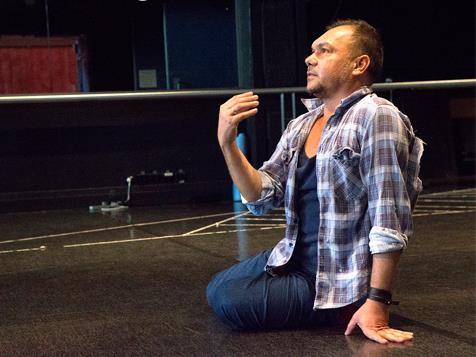Bangarra Dance Theatre Artistic Director Stephen Page. Photo by Jess Bialek
For Bangarra Dance Theatre Artistic Director Stephen Page, the story of Patyegarang – which has inspired the company’s latest production – has lingered in his consciousness for several decades; and he believes that bringing the story to life in conjunction with Bangarra’s 25th anniversary is highly fitting.
‘Working on Secret River a couple of years ago with Neil Armfield, Andrew Bovell, and Kate Grenville – and obviously Kate’s book The Lieutenant was based on Patyegarang and William Dawes – it just felt that with all those signs, the planets were lining up and it was a time to tell her story.
‘We’ve been here on Eora land for 25 years, and it was just a great way to give the people of the Eora nation a gift by awakening her spirit through this theatre experience,’ he said.
Opening on 12 June at Sydney Opera House, Patyegarang tells the true story of a young Indigenous woman who meets colonial explorer William Dawes, and is set against the backdrop of Sydney’s Walsh Bay, where Bangarra Dance Theatre has made its home for the last 16 years.
Page said the rediscovered diaries of William Dawes, on display at London’s School of Oriental and African Studies, inspired his vision for the production.
‘We only know of Patyegarang through William Dawes’ diaries. They’re quite profound and prolific. They’ve got a lot of beautiful qualities about them that somehow give you an understanding, or some sense where your imagination tries to conjure what spirit she was – which is why we call the show Patyegarang,’ he said.
Throughout the production’s development, Page has worked closely with traditional Dharug music and language.
‘Dharug elders have been very instrumental in awakening and giving breath and life into the language to help that fit into the score. We’re working with a Dharug dance songman to teach us a traditional dance from that time and reawaken the physical motifs from that time,’ he said.
‘There’s a lot of personal community involvement in the collaborations so I think that through that process, when you’re really paying homage to a legacy of a storyteller from that time, and the legacy that she left with William Dawes, and her people hundreds of years later, it’s about celebrating that spirit and finding all the right creative mediums to tell that story under the one sky, really.’
To date, Bangarra’s extensive repertoire has drawn inspiration from communities in Arnhem Land and Tasmania, and from living language, song, dance, mythology and creation stories. The company has always tried to capture what Page describes as the ‘black perspective’.
‘Thematically, Bangarra has a wonderful diversity now. But the thematic ideas we quite enjoy or tend to get some great inspiration from are perhaps the more black historical works where you go back in time and find, from a black perspective, what the spirit of the story is.’
Page hopes that Patyegarang illustrates a positive story of white and black relationships.‘This is very rare and I think that this is one of them, one that was just inspiring as a story and inspiring to tell. I don’t think that we hear enough of these stories about connections, exchanging and actually understanding and respecting each one’s culture,’ he said.
Supporting Page’s vision has been a dedicated creative team including composer David Page, designer Jacob Nash, costume designer Jennifer Irwin and lighting designer Nick Schlieper.
‘I feed them stories about what I feel, and what I have been emotionally tapping into – philosophically about how I feel about the relationship between William Dawes and Patyegarang, the time we set the work in, what textures and tones, and once we share all that we tend to come up with a theatrical structure or spine.
‘The other wonderful presence has been Alana Valentine, who was able to look into Dawes’ diaries and somehow structure all the different incidents and work out how we could find some sort of narrative spine through the stories to help us and see what direction that goes into,’ said Page.
Bangarra Designer in Residence Jacob Nash said that collaborating with Page once again has been an exciting prospect. ‘He’s so generous in the way he leads me to explore ideas, and then in responding to where the story is going. It’s always exciting to work in that way.
‘Stephen’s never told a “Sydney story” and I think he felt that it was the right time for him and the company to tell this story. You’ve got two people in history that looked at each other for the first time,’ Nash said.
‘They were from two different worlds, and asked each other questions and tried to understand each other and enjoyed sharing cultural knowledge from both sides. I think that is really important. They’re two visionaries from the past, who came together for a moment.’
Page adds that Patyegarang could also be a story of ‘what could have been’.
‘I try to think of who our William Dawes would be today. It’s certainly not Tony Abbott, but I would hope to think they would see this legacy that is a part of history. It was good will, it was a positive experience, and I hope they get the spirit of that when they’re watching this performance,’ he said.
The national tour of Patyegarang by Bangara Dance Theatre opens at Sydney Opera House from 12 June, followed by seasons at Canberra Theatre Centre, the State Theatre Centre WA in Perth, Brisbane’s QPAC, and Arts Centre Melbourne.
For tickets and more information visit the Bangarra Theatre Company website.





